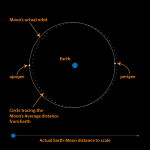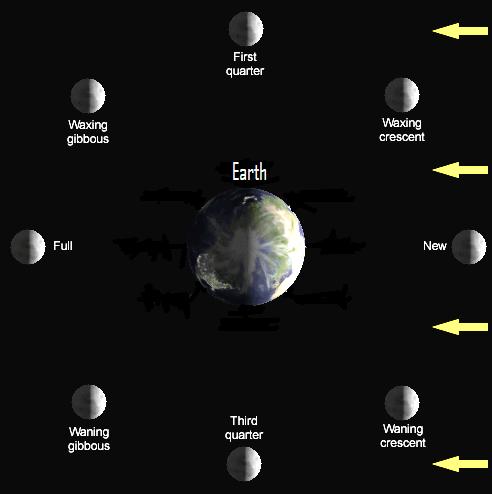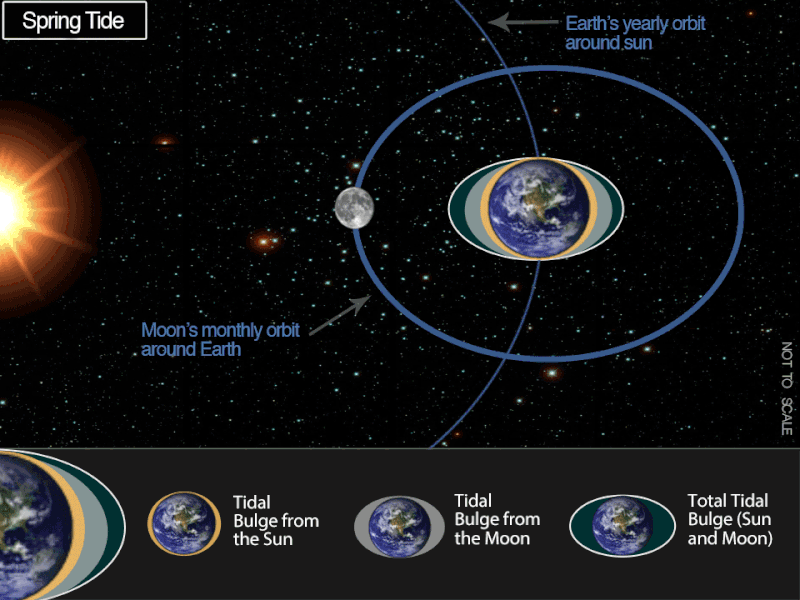
Above: The moon’s orbit around Earth is not a perfect circle. But it is very nearly circular, as the diagram above shows. Diagram by Brian Koberlein. Used with permission.
On October 16, 2020, we have the year’s closest and largest new moon. It’s a prelude to the year’s farthest and smallest full moon – also a Blue Moon, near red Mars – on October 31 (Halloween).
The Halloween Blue Moon (blue in name only) near Mars will be fun to see. Meanwhile, we won’t see the October 16 new moon, closest new moon of 2020 and thus a supermoon. We almost never see a new moon (unless there’s an eclipse) because it’s the moon phase that’s most nearly between the Earth and sun for any particular month. New moons travel across the sky with the sun all day, lost in the sun’s glare.
There are a total of 12 new moons in 2020, but this October new moon comes only about 4 hours before the moon sweeps to lunar perigee: the moon’s closest point to Earth in its monthly orbit.
New moon: October 16 at 19:31 UTC (221,797 miles or 356,948 km)
Lunar perigee: October 16 at 23:46 UTC (221,775 miles or 356,912 km)
And thus astronomers will call this October 2020 new moon a perigean new moon.

Moon’s orbit around Earth, seen from above. At new moon, the moon’s nighttime side faces Earth while the illuminated side faces the sun. At the vicinity of new moon, the moon rises and sets with the sun and is lost in the sun’s glare. Notice the full moon, too; it looks full to us because its entire illuminated side – or day side – faces Earth. Read more: Understanding moon phases
So you won’t see this new moon, even though it’s extra close. Yet if you live along a coast, you might notice its impact along the ocean shoreline in the days following new moon. Twice a month – at new moon and full moon- the gravitational pull of the moon teams up with that of the sun to usher in higher-than-usual spring tides. Around the time of a spring tide, the difference between high tide and low tide is especially profound. With this month’s closer-than-usual new moon, we can expect even higher (and even lower) tides in some places. Weather conditions and the shape of the shoreline also play a role; storms around the time of a perigean new or full moon can result in floods.
Astronomers call this sort of tide – influenced by an extra-close moon – a perigean spring tide.
Looking for a tide almanac? EarthSky recommends …

Spring tides and neap tides coincide with particular phases of the moon. Image via NOAA.
One fortnight – one-half lunar month – after this perigean new moon, we’ll have the most distant and smallest full moon of the year on Halloween (October 31, 2020). That’s because of this year’s 13 full moons, the October 31 full moon comes the closest to aligning with lunar apogee: the moon’s farthest point in its monthly orbit around Earth.
At a distance of 252,380 miles (406,166 km), this Halloween full moon is better than 30 thousand miles (49 thousand km) farther than the October 16 new moon.
Sometimes the year’s smallest full moon (apogean full moon) is called a micro-moon. This year, however, this micro-moon will also be called a Blue Moon, because it’ll be the second of two October 2020 full moons.
Read more: Blue Moon and red Mars on Halloween!
Bottom line: October 16 brings us the closest new moon of 2020. Some will call it a supermoon. You won’t see this extra-close new moon because it’ll travel across the daytime sky with the sun. But you might see its gravitational effect on the tides along ocean shorelines in the days following new moon. Watch for the perigean spring tide to give more loft to high tide, and more depth to low tide.
from EarthSky https://ift.tt/3nUKx4s

Above: The moon’s orbit around Earth is not a perfect circle. But it is very nearly circular, as the diagram above shows. Diagram by Brian Koberlein. Used with permission.
On October 16, 2020, we have the year’s closest and largest new moon. It’s a prelude to the year’s farthest and smallest full moon – also a Blue Moon, near red Mars – on October 31 (Halloween).
The Halloween Blue Moon (blue in name only) near Mars will be fun to see. Meanwhile, we won’t see the October 16 new moon, closest new moon of 2020 and thus a supermoon. We almost never see a new moon (unless there’s an eclipse) because it’s the moon phase that’s most nearly between the Earth and sun for any particular month. New moons travel across the sky with the sun all day, lost in the sun’s glare.
There are a total of 12 new moons in 2020, but this October new moon comes only about 4 hours before the moon sweeps to lunar perigee: the moon’s closest point to Earth in its monthly orbit.
New moon: October 16 at 19:31 UTC (221,797 miles or 356,948 km)
Lunar perigee: October 16 at 23:46 UTC (221,775 miles or 356,912 km)
And thus astronomers will call this October 2020 new moon a perigean new moon.

Moon’s orbit around Earth, seen from above. At new moon, the moon’s nighttime side faces Earth while the illuminated side faces the sun. At the vicinity of new moon, the moon rises and sets with the sun and is lost in the sun’s glare. Notice the full moon, too; it looks full to us because its entire illuminated side – or day side – faces Earth. Read more: Understanding moon phases
So you won’t see this new moon, even though it’s extra close. Yet if you live along a coast, you might notice its impact along the ocean shoreline in the days following new moon. Twice a month – at new moon and full moon- the gravitational pull of the moon teams up with that of the sun to usher in higher-than-usual spring tides. Around the time of a spring tide, the difference between high tide and low tide is especially profound. With this month’s closer-than-usual new moon, we can expect even higher (and even lower) tides in some places. Weather conditions and the shape of the shoreline also play a role; storms around the time of a perigean new or full moon can result in floods.
Astronomers call this sort of tide – influenced by an extra-close moon – a perigean spring tide.
Looking for a tide almanac? EarthSky recommends …

Spring tides and neap tides coincide with particular phases of the moon. Image via NOAA.
One fortnight – one-half lunar month – after this perigean new moon, we’ll have the most distant and smallest full moon of the year on Halloween (October 31, 2020). That’s because of this year’s 13 full moons, the October 31 full moon comes the closest to aligning with lunar apogee: the moon’s farthest point in its monthly orbit around Earth.
At a distance of 252,380 miles (406,166 km), this Halloween full moon is better than 30 thousand miles (49 thousand km) farther than the October 16 new moon.
Sometimes the year’s smallest full moon (apogean full moon) is called a micro-moon. This year, however, this micro-moon will also be called a Blue Moon, because it’ll be the second of two October 2020 full moons.
Read more: Blue Moon and red Mars on Halloween!
Bottom line: October 16 brings us the closest new moon of 2020. Some will call it a supermoon. You won’t see this extra-close new moon because it’ll travel across the daytime sky with the sun. But you might see its gravitational effect on the tides along ocean shorelines in the days following new moon. Watch for the perigean spring tide to give more loft to high tide, and more depth to low tide.
from EarthSky https://ift.tt/3nUKx4s

Aucun commentaire:
Enregistrer un commentaire